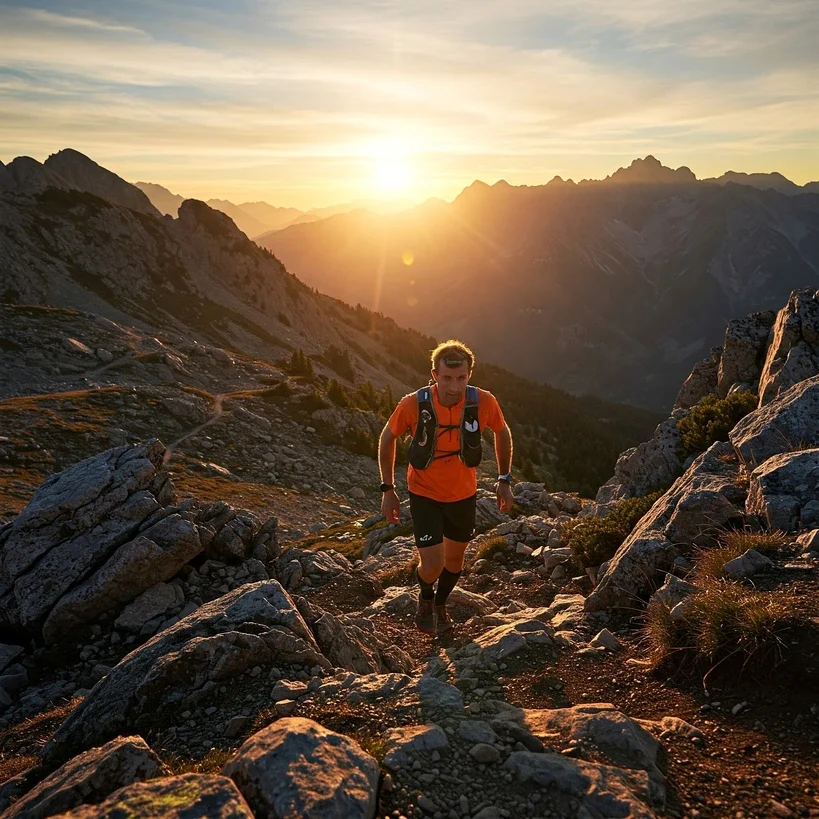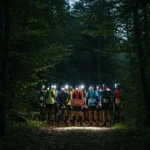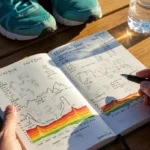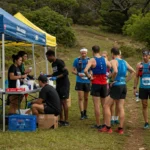The Ultimate Guide to Ultramarathon Running: Everything You Need to Know
Ultrarunning isn’t just a longer version of the marathon — it’s an entirely different universe. Whether you’re intrigued by 50K trail adventures, 24-hour track races, or grueling multi-day epics, the world of ultramarathons offers something for every endurance junkie.
But with so many distances, formats, training methods, gear options, and race types out there, where do you even begin?
Welcome to the definitive guide to ultramarathon running, your go-to resource for understanding the big picture — from the science and strategy of going long, to the spirit and culture that define this sport.
This guide is designed to help:
-
Newcomers who are curious about going beyond 42.2K
-
Experienced runners looking to refine their training and race strategy
-
Coaches, crew, and curious minds who want to better understand the ultrarunning world
We’ll cover the essentials — what ultramarathons actually are, how to train for them, the nutrition strategies that work, mental preparation, race formats, and more.
Think of this as your basecamp: the place you always come back to as you explore the many peaks of ultrarunning.
Pro tip: Bookmark this post. We’ll be updating it regularly as new races emerge, training science evolves, and gear trends shift.
Next up: What Is an Ultramarathon, Really?
(And no — it’s not just “anything longer than a marathon.” There’s more nuance than you think.)
What Is an Ultramarathon?
At its simplest, an ultramarathon is any race longer than the standard marathon distance of 42.195 kilometers (26.2 miles). But in practice, the term “ultra” encompasses a massive variety of distances, terrains, formats, and philosophies.
Common Ultramarathon Distances
While there’s no strict cap, most ultrarunners and events fall into these key categories:
-
50K: Often seen as the “entry-level” ultra. Usually trail-based, but road versions exist.
-
50 Miles / 80K: A solid step up in challenge and strategy.
-
100K: A bridge between 50-mile races and the iconic 100-miler.
-
100 Miles: Considered the gold standard of ultrarunning endurance.
-
Timed Events: Run as far as possible in 6h, 12h, 24h, 48h, or even 6-day formats.
-
Multi-Day Events: Examples include the Marathon des Sables or Big Dog’s Backyard Ultra.
Some of these races climb mountains. Others circle tracks or loop through parks. What matters isn’t just the distance — it’s how you approach it.
Road, Trail, Track, and “Other”
Ultramarathons are as varied as the terrain they cover:
-
Trail Ultras: Often feature steep climbs, technical descents, and variable surfaces.
-
Road Ultras: Focused more on pace and efficiency. Great for beginners.
-
Track Ultras: Mind over matter. Think of 24 hours on a 400m loop.
-
Backyard Ultras: A new format where runners complete a loop every hour — until only one remains.
Some races require navigating with GPS. Others offer aid every mile. No two ultras are truly the same — and that’s part of the magic.
It’s More Than Just Distance
Ultrarunning is as much mental as it is physical.
You don’t just “run farther” — you:
-
Learn to manage pain and fatigue over hours or days.
-
Ration energy, calories, electrolytes, and motivation.
-
Deal with heat, cold, sleep deprivation, hallucinations, and self-doubt.
-
Develop resilience and a deep connection to your mind and environment.
And more often than not, it’s not just about finishing first — it’s about finishing at all.
A Brief History of Ultrarunning
Before “ultramarathon” was a word, humans were already running ultra distances — for survival, for communication, for glory. Ultrarunning isn’t just a niche sport; it’s a return to our deep evolutionary roots.
Pedestrianism: The 19th Century Ultra Boom
Long before marathons became mainstream, pedestrianism — competitive long-distance walking and running — was one of the most popular sports in the Western world.
-
In the 1800s, indoor arenas in the U.S. and UK hosted 6-day races drawing thousands of spectators.
-
Athletes covered 500–600 miles in a week — sleeping in short bursts, running in circles, fueled by raw determination (and, occasionally, champagne).
-
Prize money rivaled boxing or horse racing.
Though it eventually faded, pedestrianism proved the human capacity — and appetite — for ultradistance events.
Ancient Footraces & Legendary Feats
Even earlier:
-
Pheidippides, the Greek messenger, famously ran from Athens to Sparta — 240km (150 miles) — not the 42km marathon myth we hear today.
-
Tarahumara runners in Mexico continue a tradition of long-distance running across rugged terrain — often racing 100+ miles in sandals.
-
In East Africa and Mongolia, nomadic cultures incorporated ultra distances into daily life.
For many cultures, ultrarunning wasn’t a sport — it was a way of life.
️ The Modern Trail Ultra Movement
The late 20th century saw ultras move off roads and tracks and into the wild:
-
Western States 100 (California, 1977) — the oldest 100-mile trail race — sparked global interest.
-
UTMB (France, 2003) turned mountain ultrarunning into a mass phenomenon, blending alpine adventure with elite competition.
-
Backyard Ultra, Tor des Géants, Barkley Marathons — each brought new formats, challenges, and legends.
Today, the ultrarunning calendar is packed year-round with events in deserts, jungles, tundra, and cityscapes alike.
Types of Ultramarathons & Race Formats
Ultrarunning isn’t defined just by distance — it’s a universe of formats, philosophies, and finish lines. Whether you’re chasing cutoffs on a snowy peak or hammering loops on pavement, there’s an ultra for every kind of runner.
Distance-Based Events
These are the most common types of ultramarathons — categorized by how far you run:
| Distance Name | Kilometers | Miles | Common Examples |
|---|---|---|---|
| 50K | 50 | 31 | Intro ultra, often trail-based |
| 50 Mile | ~80 | 50 | Stepping stone toward 100s |
| 100K | 100 | 62 | Often technical and international |
| 100 Mile | 160 | 100 | “The big one” — a life goal for many |
Most races come with elevation, terrain, or heat challenges that make the mileage feel twice as long.
⏱️ Time-Based Events
Here, the clock matters more than the distance:
-
6-hour, 12-hour, 24-hour races — often held on flat loops or tracks. Your goal? Cover as much ground as you can.
-
48-hour and 6-day races — a test of strategy, sleep deprivation, and mental durability.
-
Popular in road/track ultra culture and “pedestrianism” throwbacks.
These races reward pacing, patience, and nutrition mastery.
Loops, Backyard & Elimination Formats
-
Backyard Ultras: Run 6.7 km every hour on the hour. Last runner standing wins.
-
Last-Man-Standing Events: Similar, but formats may vary slightly.
-
Fixed Loop Races: Many time-based events use 1–2 km loops. Mental focus is key.
These races are deceptively hard and brutally addictive.
️ Trail vs. Road vs. Track
-
Trail Ultras: Single-track, fire roads, technical terrain. Adventure + survival.
-
Road Ultras: Flat, fast, often urban (e.g., Comrades Marathon, Spartathlon).
-
Track Ultras: 400m loops for pure endurance metrics and record attempts.
Each surface demands unique gear, mindset, and training philosophy.
How to Choose Your First Ultra
Ask yourself:
-
Do I want nature, pavement, or laps?
-
Is my strength endurance, speed, or mental grit?
-
Do I want a scenic experience or a PR attempt?
50K trail ultras are often the best first step — challenging yet accessible.
How to Train for an Ultramarathon
Training for an ultramarathon isn’t just about running farther — it’s about rewiring your entire relationship with endurance, recovery, time management, and even suffering. Below is a deep-dive into how top-tier runners and weekend warriors alike prepare for the long haul.
️ Build Your Base: Weekly Volume & Consistency
Before worrying about back-to-backs or hill repeats, establish a solid weekly volume.
-
4–6 days/week running is ideal.
-
Focus on gradual mileage increase: +10% per week max.
-
Emphasize time on feet, not just pace.
-
Aim for a 12–20 week training block, depending on race distance.
Think of this phase as laying the bricks of your ultra house.
Sample Training Week (for a 50K Trail Ultra)
| Day | Workout |
|---|---|
| Monday | Rest / Yoga / Mobility |
| Tuesday | Hill Repeats or Threshold Tempo (45–60 min) |
| Wednesday | Easy Recovery Run (60 min) |
| Thursday | Moderate Distance Run (90 min) |
| Friday | Rest or Optional Easy Run (45 min) |
| Saturday | Long Run on Terrain (2–5 hours) |
| Sunday | Medium-Long Run (90 min–2 hours) |
Back-to-back long runs simulate race fatigue and mental wear.
️ Terrain Specificity & Vertical Training
Ultras are rarely flat. Train for:
-
Elevation Gain & Loss — uphills burn, but downhills bruise.
-
Technical Trails — roots, rocks, switchbacks.
-
Heat, cold, or altitude — simulate race conditions when possible.
If your race has 4,000m of climbing, your legs should meet that elevation at least once before race day.
Nutrition in Training
Ultra success is 50% fueling.
-
Train your gut to handle 30–60g carbs/hour minimum.
-
Practice eating solids and liquids on the run.
-
Avoid trying anything new on race day.
Hydration, salt balance, and GI comfort matter more than you think.
Taper Smart
3–4 weeks before your race, reduce volume:
-
Keep intensity, reduce duration.
-
Focus on sleep, nutrition, and mobility.
-
Mental prep: review the course, gear, nutrition plan.
A good taper leaves your legs rested but your mind sharp.
Common Ultramarathon Problems (and How to Solve Them)
No matter how well you train, ultras will throw curveballs. That’s the game. The key is learning to solve problems on the fly, before they end your race.
1. Chafing & Blisters
Symptoms: Burning skin, raw thighs, feet that feel like they’ve run through fire.
Solutions:
-
Lube early, lube often: Vaseline, Body Glide, or Trail Toes in all friction zones.
-
Dress for success: Seamless, sweat-wicking gear.
-
Blister tape (e.g. Leukotape) before hotspots form.
-
Change socks/shoes at drop bags if soaked.
Pro Tip: Use a handheld spray of water to clean salty skin mid-race. Salt crystals are like sandpaper.
2. Bonking / Energy Crashes
Symptoms: Sudden fatigue, dizziness, mental fog.
Solutions:
-
Fuel every 30–45 min — even when not hungry.
-
Mix fast carbs (gels) and slow carbs (bars, potatoes).
-
Add electrolytes to every 500ml of fluid.
-
Use caffeine strategically: late-race or after bonk onset.
Recovery Tip: If bonk hits, stop. Eat. Walk 10 min. Restart with purpose.
3. Mental Lows & Hallucinations
Symptoms: Wanting to DNF, crying, seeing dragons in tree stumps.
Solutions:
-
Break race into aid station to aid station.
-
Have a mantra: “One more step. One more mile.”
-
Music, audio books, or pre-recorded voice memos from friends.
-
Practice mental fatigue: night runs, long solo efforts.
4. Overheating / Hypothermia
-
Hot Races: Ice bandanas, water over the head, slow pace in exposed climbs.
-
Cold Races: Layers, windbreakers, waterproof gloves. Keep moving to avoid chill.
Know how your body responds to temp swings. Test it during training.
5. GI Distress (The Dreaded Porta-Potty Run)
Symptoms: Nausea, bloating, diarrhea, the “Code Brown.”
Solutions:
-
Test everything in training.
-
Eat real food early; switch to gels when digestion slows.
-
Use ginger chews, peppermint gum, or cola for nausea.
-
Avoid NSAIDs — they increase GI risk.
6. Muscle Cramping
Not always a salt issue. Can also be from overexertion or undertraining.
Solutions:
-
Train hills and long descents to build durability.
-
Stretch and walk through cramps — don’t stop cold.
-
Keep up with electrolyte intake, but don’t overdo it.
Bonus: Drop Bag Strategy to Save the Day
Use drop bags to preempt problems:
-
Dry socks & shoes
-
Extra lube & tape
-
Favorite snacks or Coke
-
Motivational notes or photos
-
Headlamp backup + batteries
Essential Gear for Ultramarathons (What to Wear, Carry & Trust)
Forget fancy. Focus on function. Everything you wear or carry must serve one goal: get you to the finish line in one piece.
Shoes: Your Ultra Lifeline
Trail or road, your feet take the hit.
-
Test multiple pairs well before race day.
-
Drop matters: zero-drop may stress calves; higher drop helps downhill.
-
Toe box width is crucial — swelling is real.
-
Always bring a backup pair to a drop bag.
Popular Ultra Shoes: Altra Lone Peak, HOKA Speedgoat, Salomon Ultra Glide, Nike Zegama.
Socks: More Than Just Fabric
The first line of defense against blisters.
-
Merino or synthetic blends.
-
Double-layer or toe socks (Injinji) can prevent hotspots.
-
Change socks if soaked — no exceptions.
Clothing: Comfort Over Cool
Top Priorities:
-
Moisture-wicking.
-
Seamless if possible.
-
Layerable for variable temps.
Pack arm sleeves, buff, rain jacket, and a warm layer if you’re going long or overnight.
Pro Tip: A lightweight windbreaker saves lives on exposed ridgelines.
Vest / Pack: Your Mobile Aid Station
Your vest should carry:
-
1–2L water (soft flasks or bladder)
-
Nutrition for 2–3 hours
-
First aid + lube
-
Mandatory gear (headlamp, map, whistle, etc.)
Fit is everything — try loaded test runs before race day.
⛑ Mandatory Kit (Especially for Mountain Ultras)
-
Headlamp (with backup batteries)
-
Whistle
-
Space blanket
-
Waterproof jacket
-
Course map / GPS
-
Poles (if allowed/needed)
Tech & Tools
-
GPS Watch (with ultra mode): Coros, Garmin, Suunto.
-
Foot care kit: blister tape, safety pins, scissors.
-
Ziplock bags: waste, salt tabs, wet gear.
-
Power bank if your race is longer than your battery life.
Night Running Gear
-
300+ lumen headlamp (and a backup)
-
Reflective vest or strips
-
Backup handheld or clip-on light for depth perception
Night miles are different miles. Practice in the dark before race day.
️♂️ Training Approaches for Ultramarathon Success
Ultras aren’t just longer marathons. They’re an entirely different species. Training for one means reshaping your endurance, mindset, and life habits.
Mindset First: Build Mental Muscle
The body can only go as far as the mind lets it.
Ultramarathons are 50% physical, 50% mental… and 100% personal.
-
Train in discomfort: heat, rain, hunger, fatigue.
-
Embrace boredom and silence — they’re part of the game.
-
Visualize problem-solving during your long runs.
“If you don’t train your mind, your legs won’t matter past 60K.”
♀️ Base Building Phase (8–12 Weeks)
Key goal: aerobic strength.
-
4–6 days of running per week.
-
1 long run per weekend — slowly ramping.
-
Back-to-back long runs every 2–3 weeks.
-
Most runs should be easy pace, Zone 2.
“Don’t chase pace. Chase time on feet.”
⛰️ Specificity Phase (6–10 Weeks)
Simulate your race.
-
Train on similar terrain and elevation.
-
Hill repeats, technical trail work, power hiking.
-
Practice with race gear and nutrition.
-
Add longer back-to-back runs (25–50K each).
Nutrition Training
Train your gut like you train your legs.
-
200–300 calories/hour is the general rule.
-
Mix carbs (gels, drink mix, real food).
-
Practice with caffeine, electrolytes, fiber, etc.
-
Hydrate based on conditions — not thirst alone.
“Your gut is an endurance organ. Teach it well.”
Strength & Mobility (All Phases)
-
2x/week strength sessions: core, glutes, hamstrings.
-
Mobility drills post-run.
-
Injury prevention: hips, ankles, knees.
Recovery = Secret Weapon
-
At least one full rest day/week.
-
Sleep 7–9 hours (non-negotiable).
-
Post-long-run recovery routine (protein, feet up, stretch).
Sample Weekly Plan (Mountain 100K – Mid Volume)
| Day | Focus |
|---|---|
| Monday | Rest or short recovery run |
| Tuesday | Hill repeats or tempo |
| Wednesday | Easy run + strength |
| Thursday | Trail intervals or strides |
| Friday | Easy run or full rest |
| Saturday | Long trail run (3–6 hrs) |
| Sunday | Medium long run (2–4 hrs) |
⚙️ Common Ultramarathon Challenges & How to Fix Them
Every ultra tests your limits. These are the monsters you will face — and how to beat them.
GI Distress
The Problem:
Cramps, nausea, diarrhea — the stomach quits before the legs.
Fixes:
-
Train your gut in long runs (fuel every 30 mins).
-
Limit fiber, fat, and dairy 24–48 hours pre-race.
-
Try ginger chews, flat Coke, or salt tabs when nausea hits.
-
Use what worked in training only — race day is not a buffet.
Overheating & Dehydration
The Problem:
Sweating buckets, losing salt, cramps incoming.
Fixes:
-
Hydration plan = weight-based + weather-adjusted.
-
Electrolytes are non-negotiable.
-
Wear light colors, use ice (buff, sleeves, hat), sponge off.
-
Adjust pace during the heat — be humble or be humbled.
Hypothermia
The Problem:
Shivering, clumsy hands, slurred words — it’s serious.
Fixes:
-
Know the forecast. Be overdressed > underdressed.
-
Layer smart: base + windproof shell.
-
Keep hands and core warm. Wet gloves = trouble.
-
Emergency bivvy/foil blankets in drop bags.
Blisters & Foot Pain
The Problem:
Hot spots become show-stoppers.
Fixes:
-
Lube feet (Squirrel’s Nut Butter, Vaseline, etc.).
-
Test socks/shoes combo during long runs.
-
Tape prone areas with Leukotape or KT tape.
-
Dry socks in drop bags. Consider gaiters for debris.
Mental Collapses & DNF Demons
The Problem:
You want to quit. Everything hurts. Why are you even here?
Fixes:
-
Have a “Why” and rehearse it during training.
-
Break race into chunks (next aid station, next hill).
-
Talk to your crew/pacers. Or fake it till you laugh.
-
Power walk, fuel, reset. You’re allowed to be slow — just don’t stop.
“When your mind says stop, take one more step. That’s the win.”
Sleep Deprivation (100M+)
The Problem:
Hallucinations. Microsleeps. Losing time, getting lost.
Fixes:
-
Practice overnight runs in training.
-
Nap before race and in drop bags (if needed).
-
Caffeine: dose small and strategically — don’t burn it all early.
-
Plan hallucination breaks. A 10-min sit may reboot you.
Bonking & Low Energy
The Problem:
Dead legs, tunnel vision, you feel like an empty shell.
Fixes:
-
Fuel early, fuel often — don’t wait for hunger.
-
Alternate between sweet/salty textures.
-
Hit a low? Hike, fuel, and smile. Most lows pass in 20–40 mins.
-
Avoid rookie mistakes: under-fueling early is the #1 killer.
Ultramarathon Culture Around the World
Ultrarunning isn’t just a sport. It’s a global ritual with trailheads from the Alps to the Andes — and each corner of the earth adds its own flavor of suffering.
USA: The Birthplace of Trail Grit
-
Western States 100: The original. 1974. Medical forms, rattlesnakes, and legendary switchbacks.
-
Leadville 100: High altitude, thin air, and “You are tougher than you think you are.”
-
Culture: Cowboy hats, Tailwind, buckle finishes, and volunteers that treat you like royalty.
Notable Vibe: Crew-heavy, well-supported, tight-knit community. You’ll see more tattoos than compression socks.
France: The Alpine Mecca
-
UTMB (Chamonix): The Superbowl. 170 km around Mont Blanc. Feels like a festival, broadcasts like the Tour de France.
-
La Diagonale des Fous (Reunion): Tropical hellscape. Elevation and humidity.
-
Culture: Technical terrain, poles, vests packed to the brim.
Gear rules are enforced, and runners train like road pros.
Notable Vibe: Elite-dominant field, lots of mandatory gear, fans cheer “Allez, allez!” even at 3AM.
Japan: Discipline Meets Nature
-
Hasetsune Cup: No pacers, no GPS, no nightlight checks. Just you and the mountain.
-
Fuji Ultra Trail: UTMB affiliate. Beauty + brutality.
-
Culture: Quiet strength, personal honor. Aid stations like sushi bars.
Notable Vibe: Minimalist, respectful, super-prepared. Lots of lone wolves in the dark.
South Africa: History in Stride
-
Comrades Marathon (89 km): Road ultra, over 100 years old. The world’s oldest.
Alternates uphill/downhill years. -
Culture: National pride. Spectators feed you on the streets. Entire towns line up to cheer.
Notable Vibe: Party atmosphere, unity, full-body commitment.
Turkey: Where Continents Collide
-
Kaçkar by UTMB: High alpine meadows + remote trails + serious vertical.
-
Cappadocia Ultra Trail: Fairy chimneys, historical trails.
-
Culture: Growing fast. Rugged terrain, warm aid stations, and strong local community support.
Notable Vibe: Wild beauty meets old-world challenge. Still niche — you’ll feel like a pioneer.
Other Icons to Know
-
Spartathlon (Greece): 246 km. Hot tarmac. Ancient spirit.
-
Barkley Marathons (USA): 5 loops, no GPS, 1% finish rate.
-
Tor des Géants (Italy): 330 km monster. Sleep-deprivation ballet.
6. Gear, Tech & Nutrition: The Ultrarunner’s Toolbox
When your races span hours — or even days — your gear and fueling strategy matter as much as your training. The wrong shoes, an incompatible GPS watch, or mismanaged nutrition can turn a solid race into a miserable DNF. Here’s what really matters (and what doesn’t) in your ultrarunning toolbox.
Footwear: Not Just About Comfort
-
Trail or Road? Match your shoes to the terrain. Trail ultras need grip and rock plates. Road ultras demand cushioning and responsiveness.
-
Drop, Stack, and Fit: Low drop shoes may promote a more “natural” gait, but high stack shoes like HOKA’s can save your legs in long events.
-
Test Before You Race: Never race in untested shoes. Blisters, hot spots, or black toenails can derail even your best efforts.
Pro Tip: Carry a spare pair at drop bags for long ultras. Wet shoes = disaster.
Apparel & Accessories
-
Layering is King: Weather shifts drastically over 50–100 miles. Light base layers + packable wind/waterproof shells are crucial.
-
Chafing Prevention: Anti-chafe balms, compression shorts, and seamless designs prevent raw skin (one of the most common DNFs in ultras!).
-
Socks Matter More Than You Think: Merino blends, double-layer socks, or Injinji toe socks — test them all.
⌚ GPS Watches & Running Tech
-
Battery Life is Crucial: Go for watches with 24h+ GPS (e.g., Coros Vertix, Garmin Enduro). Mid-race charging is a huge risk.
-
Custom Data Fields: Set up pace, HR zones, distance-to-aid, etc. so you’re not guessing mid-race.
-
Mapping & Navigation: Trail ultras often require route-finding. Make sure your device supports GPX file uploads and offline maps.
Nutrition: What Fuels the Ultra Machine
-
Caloric Intake: Aim for 200–300 calories/hour during racing. More isn’t always better — digestion slows at high intensities.
-
Hydration Strategy: Combine electrolytes, not just water. Hyponatremia (overhydration without salt) is a serious risk.
-
Gels vs. Real Food: Gels work for short bursts. For 100Ks and longer, add solid foods: nut butters, bananas, mashed potatoes, even rice balls.
⚠️ Don’t Try Anything New on Race Day. Every fueling strategy must be tested in training.
Packs, Poles, and Beyond
-
Vests & Belts: Should carry your mandatory gear without bounce. Salomon, Nathan, and UltrAspire are ultra favorites.
-
Poles: In mountainous races (e.g., UTMB), poles can reduce fatigue by offloading work to your upper body.
-
Headlamps: Don’t forget lumen power + spare batteries. Night running is a whole different beast.
️♂️ 7. Training for Your First (or Fastest) Ultra
Training for an ultramarathon isn’t just “marathon plus extra miles.” It’s a completely different animal. You’re not just building endurance — you’re building durability, resilience, and fatigue management skills. Here’s how to train smart — and arrive at the start line ready to crush it.
Build the Base: The Foundation Phase
Before you even start thinking about big back-to-back long runs, you need a strong aerobic base.
-
Time on Feet > Speed: Focus on running for time, not pace or distance early on.
-
Consistency Beats Volume: 4–5 steady runs a week trumps one epic long run.
-
Build Slowly: 10% weekly increase rule still applies. Don’t rush your mileage.
Injury Alert: Skipping this phase is the #1 cause of overuse injuries in new ultrarunners.
Long Runs, Back-to-Backs & Simulation Days
Long runs are your ultra dress rehearsals.
-
Weekend Double Runs: Back-to-backs train your legs to run tired — essential for race day.
-
Race Simulation Days: Pack your vest, test your food, practice aid-station stops.
-
Terrain Specificity: Training for trails? Run trails. Mountain ultra? Get vertical.
Train your mind too: no music, no podcasts — just silence and your thoughts.
Periodization & Ultra Blocks
Ultramarathon training is typically broken into:
-
Base Phase (8–12 weeks): Build endurance.
-
Build Phase (6–10 weeks): Increase volume, long runs, vert.
-
Peak Phase (2–3 weeks): Big back-to-back weekends, race rehearsals.
-
Taper (2–3 weeks): Sharpen while reducing volume.
Repeat this cycle yearly for progressive gains — ultra success is a long game.
Recovery & Supporting Work
-
Sleep is King: 8+ hours isn’t luxury — it’s the training you’re not doing.
-
Strength Work: Twice a week. Think mobility, glutes, core, single-leg work.
-
Rest Weeks: Every 3–4 weeks, drop mileage by 40–50% and let adaptation happen.
Listen to your fatigue — not your ego. Burnout kills ultra dreams.
Coaching vs. DIY
-
Coaching Helps: Especially for first-timers, busy professionals, or PR-focused runners.
-
DIY? Stick to proven plans (Jason Koop, Krissy Moehl, or TrainingPeaks-based programs).
-
Community Training Groups: Local ultra clubs or Strava groups can boost motivation and accountability.
8. Mindset & Mental Training in Ultramarathons
Ultras push the body to its limits — but it’s your mind that gets you across the finish line. Whether you’re facing a cold night, gut issues, or soul-crushing climbs at mile 70, your mental game is the make-or-break.
Emotional Rollercoaster? Expected.
Ultras are a journey through joy, doubt, boredom, pain, euphoria… sometimes all within an hour.
-
Accept the Lows: They’re part of the experience, not a sign of failure.
-
Mantra Time: Short phrases like “relentless forward motion” or “you’re doing fine” work wonders.
-
Don’t Trust Mile 60 Thoughts: Never make decisions (like quitting) at your lowest point.
Veteran Tip: “Smile when you feel the worst. It tricks your brain and changes the vibe.”
Mental Training You Can Actually Do
-
Visualization: See yourself finishing strong. Play it like a movie.
-
Meditation: Even 5–10 mins a day helps with focus and breath control.
-
Discomfort Reps: Cold showers, hill repeats, running without entertainment — learn to be uncomfortable.
“Train the mind like a muscle” isn’t a cliché — it’s the ultra secret sauce.
Overcoming the “Why Am I Doing This?” Wall
You’ll ask it. Maybe 5 times.
-
Write Your ‘Why’ Down: Seriously. Bring it with you.
-
Break the Race into Chunks: Aid station to aid station. Segment by hours or climbs.
-
Phone a Friend: Have a pacer or remote support call scheduled.
Goal Reminder: Whether it’s proving something to yourself or raising money for a cause — keep that reason front and center.
Mental Toughness ≠ Ignoring Pain
Being mentally strong isn’t about pushing through injury or running into a wall.
-
Smart Grit: Know the difference between pain that passes and damage that lasts.
-
The Toughest Runners Know When to Pull the Plug: Courage isn’t always finishing — it’s making the right call.
Your best ultra mindset is equal parts fire and wisdom.
9. Gear & Equipment: What You Actually Need
Ultrarunning gear can be both your lifeline and a massive distraction. The trick? Dialing in your setup — based on terrain, weather, and personal preference.
Let’s separate the essentials from the shiny extras.
Mandatory Kit vs. Smart Kit
Mandatory gear is often race-specific (especially in mountain races). But here’s what most ultras demand or smart runners pack:
| Gear | Why It Matters |
|---|---|
| Hydration Vest | Carries water, food, layers — your mobile aid station. |
| Headlamp | For night sections or early starts. Bring spare batteries. |
| Emergency Blanket | Often required. Life-saver in cold/wet conditions. |
| Whistle & ID | Safety items — required by many mountain races. |
| Waterproof Jacket | Breathable, lightweight. Not optional in the Alps. |
| Nutrition Supply | Enough calories between aid stations. Practice with these. |
Bonus: Use ziplocks for organization. One for food, one for meds, one for wet stuff.
Shoes: Trail vs. Road vs. Max Cushion
-
Trail Shoes: Grippy outsole, rock plates, toe protection. A must on technical terrain.
-
Max Cushion (like HOKA): Great for long runnable ultras. Soft, but some lack grip.
-
Drop (heel-to-toe): Experiment in training. Don’t go zero-drop the week before your race.
Break them in over 100+ km. And yes, pack a second pair if the course is wild.
The Unsung Heroes: Socks, Lube & Tape
-
Socks: Merino blend or technical synthetic — blister protection matters.
-
Lube: Vaseline, Squirrel’s Nut Butter… for toes, thighs, chest. You know the drill.
-
Tape & Band-Aids: For hot spots or emergencies. Leukotape = gold.
Pro Hack: Cut your tape ahead of time and stick to wax paper.
Tech Toys: GPS, Poles, Power Banks
-
GPS Watch: Battery life is king. Course loading helps.
-
Poles: Total game-changer for mountain ultras. Practice early.
-
Phone + Power Bank: For safety, tracking, and selfies at the summit.
Tip: Put your phone on airplane mode — saves battery, still works for photos.
Gear gets you through. It doesn’t win the race — you do. But smart prep keeps you comfortable, safe, and a whole lot happier out there.
10. Nutrition & Hydration Strategy: Fuel or Fail
“You don’t rise to the level of your training. You fall to the level of your nutrition.”
– Every ultrarunner after vomiting at mile 60.
The Science of Fueling for Ultras
Your body can only absorb about 60–90g of carbs per hour — beyond that, GI issues knock. But your brain and muscles need that sugar to keep firing. Here’s the balance:
-
Carbs: 60–90g/hour. Use gels, drink mix, rice balls, candy, whatever works.
-
Electrolytes: Sodium is king. You lose 500–1,500mg/hour depending on heat & sweat.
-
Fluids: ~500–750ml/hour. More in hot conditions.
Use your training runs to simulate race nutrition. Never try new fuel on race day — unless you enjoy porta-potty roulette.
What to Eat (and When)
| Time | Fuel Type | Examples |
|---|---|---|
| Pre-race | Low-fiber, carb-rich | Oatmeal, toast + peanut butter, banana |
| During (early) | Simple carbs, gels | Maurten, GU, chews, Tailwind |
| Mid-race | Variety helps | Fruit, small sandwiches, broth, potatoes |
| Late-stage | Whatever you can stomach | Coke, soup, chips, pickle juice |
Gut shutting down? Sip ginger ale, chew ginger candy, slow down. Walk it out.
Hydration Rules & Salt Strategy
Dehydration = game over. Overhydration = hyponatremia = worse.
-
Sweat test: Weigh before/after a hot long run. Aim to replace ~75% of lost weight via fluid.
-
Salt caps: Try S-Caps, SaltStick, or sports drinks with sodium.
-
Urine check: Dark = bad. Clear = overhydrated. Pale yellow =
Rule of thumb: If your fingers swell, drink less water + more salt.
️ Practice Like You Race
Do every long training run with your planned race fuel.
“Ultras are not about training harder. They’re about screwing up less.”
Build your gut just like you build your quads.
✅ Mini Nutrition Checklist (pre-race week):
-
Pre-packed gels or food for each hour
-
Electrolyte plan (caps or drinks)
-
Tested race breakfast
-
Gut-trained with full gear & race effort
⛑️ 11. Common Mistakes & How to Avoid Them
“It wasn’t the mountain that beat me. It was the 6 dumb things I did before mile 40.”
– Every ultrarunner, at some point.
Mistake 1: Starting Too Fast
Why it happens: Adrenaline, fresh legs, the guy next to you is sprinting.
Fix: Use a pace cap. You should feel too slow the first hour. Run with effort, not ego.
Mistake 2: Poor Hydration Strategy
Why it happens: Weather changes, aid stations farther than expected, nausea.
Fix: Test in training. Have backup hydration (like tablets in your vest).
Mistake 3: Trying New Things on Race Day
Why it happens: Temptation at aid stations.
Fix: If you didn’t train with it, don’t touch it. Exception: watermelon is usually safe.
Mistake 4: Not Studying the Course
Why it happens: Trusting course markings, skipping the map.
Fix: Study elevation profile. Know when climbs hit. Use a cheat sheet on your wrist.
Mistake 5: Bad Gear Choices
Why it happens: Cheap gear, untested socks, new shoes.
Fix: Do a dress rehearsal run with full gear. Test socks, lube, vest, lights.
Mistake 6: Ignoring Mental Preparation
Why it happens: Overconfidence.
Fix: Train mental grit. Rehearse dark thoughts — then crush them with mantras.
️ Mistake 7: Sunburn, Chafing, Blisters
Why it happens: Rushing race morning.
Fix: Sunscreen, anti-chafe, and foot taping are non-negotiables.
Mistake 8: No Plan B (or C)
Why it happens: Believing everything will go perfectly.
Fix: Ask yourself: “What will I do if I puke? If my headlamp dies? If it rains?”
Prep for chaos.
Mistake 9: Ignoring the Aid Station Trap
Why it happens: You sit. You eat. You fade.
Fix: Move through like a Formula 1 pit stop. Sit only if needed. Have a checklist.
Mistake 10: Letting Small Problems Become Big
Why it happens: “It’s just a hotspot.” 20K later: “My foot is raw.”
Fix: Fix everything early. Small pain? Address it now.
Boss mantra: “Don’t aim for perfection. Aim to screw up less than others.”
12. Stats, Records & Ultra Milestones
“You can’t measure heart, but you can measure what it goes through.”
– Unknown ultra timer at Western States
Fastest Known Times (FKTs)
-
Western States 100:
– Jim Walmsley: 14:09 (2019)
– Ellie Greenwood: 16:47 (2012) -
UTMB:
– Kilian Jornet: 19:49 (2022)
– Courtney Dauwalter: 22:30 (2021) -
Badwater 135 (Death Valley, USA):
– Yoshihiko Ishikawa: 21:33
– Michele Graglia: top finisher multiple times
Oldest, Youngest, Wildest
-
Oldest finisher (Spartathlon): over 70 years
-
Youngest 100K finisher: sometimes as young as 18
-
Fastest “calendar slam” (all 4 100-milers in US):
– Done in under 70 days!
Common Milestones
-
First 50K: entry-level ultra
-
First 100K: “Welcome to the grind”
-
First 100 miler: You’re officially part crazy
-
⬛ 200+ milers: The Barkley class of runners
What Do Runners Actually Finish?
-
100K finish rates: ~70–85%
-
100 mile finish rates: ~55–75%
-
Tor des Géants (330 km): ~55%
-
Barkley Marathons: <1% finish rate
Nutrition & Numbers (Average)
| Race | Calories/hr | Water/hr | Salt/hr |
|---|---|---|---|
| 50K | 150–200 | 500ml | 300–500mg |
| 100K | 200–250 | 600ml | 400–700mg |
| 100M | 250–300 | 700ml | 500–800mg |
Cool stat: Most DNFs happen between 70-90% of the distance. Why? Because the end is near, but not near enough.
13. Ultra Gear Guide: What You Actually Need
“Your gear can either serve you or sabotage you.”
– Every runner after a blister-filled 100K
The Mandatory Kit (And Why It Exists)
Most long-distance ultras (especially in the mountains) require a mandatory kit. Here’s what usually shows up and what it’s actually for:
-
Headlamp (with extra batteries) → Night visibility & safety
-
Whistle → Emergency alert system
-
Survival blanket → Heat retention in cold shock
-
Waterproof jacket → Hypothermia prevention
-
Course map / GPS watch → Self-navigation when signage fails
-
Mobile phone (fully charged) → Communication & tracking
-
Collapsible cup → Eco-friendly, no cup races
-
Minimum 1L water capacity → Hydration insurance
✅ Pro tip: Always test your gear before race day. Brand-new = high risk.
Shoes, Socks, and Soles
-
Trail shoes: prioritize grip, not just cushioning
-
Toe socks (like Injinji): prevent blisters between toes
-
Gaiters: keep pebbles out of shoes = no pain, no problem
Clothing: Comfort Meets Climate
-
Layer system: Base (moisture-wicking), Mid (warmth), Shell (protection)
-
Chafe-proof underwear: don’t laugh — this is a make-or-break
-
Arm sleeves & Buff: versatile for heat, cold, and sun
Hydration & Fueling Systems
-
Hydration vests: soft flasks in front = easy access
-
Flasks vs bladder: flasks = refillable & visible; bladder = more volume
-
Pockets: stash gels, salt pills, phone, gloves, whatever
Extras Worth Packing
-
Salt tabs & anti-cramp gel
-
Tiny anti-chafe balm (BodyGlide, Squirrel’s Nut Butter)
-
Toilet paper or wet wipes (you’ll thank yourself)
-
Tiny zip bag for trash (don’t litter, trail karma matters)
⚠️ Common Gear Mistakes
-
“Trying something new” on race day
-
Overpacking like it’s Everest
-
Not checking headlamp batteries
-
Forgetting to trim toenails!
Ultra wisdom: Good gear doesn’t make you faster — it just makes you suffer less.
14. Recovery: What Happens After 100K?
“The finish line is just the beginning of recovery.”
– Every ultrarunner’s quads, the next day
Mental Crash is Real
Ultras test your brain as much as your body. After weeks (even months) of buildup, it’s normal to feel:
-
Post-race blues
-
Motivation dip
-
Loss of purpose
Action step: Plan your recovery like you planned your race. Even a light goal like “3 yoga sessions this week” helps.
Physical Fallout (and Healing Time)
Expect:
-
DOMS (Delayed Onset Muscle Soreness)
-
Swollen feet / ankles
-
Gut distress
-
Sleep disturbance
⏱ Recovery timeline:
| System | Time Needed |
|---|---|
| Muscles | 7–10 days |
| Joints | 10–21 days |
| Hormones | 2–4 weeks |
| Gut / GI | 3–5 days |
| Mental Energy | 1–3 weeks |
Nutrition: Rebuilding Phase
Post-race window is your chance to repair deep damage:
-
Protein + carbs within 1 hour → muscle rebuild
-
Anti-inflammatories via food: turmeric, ginger, berries
-
Hydration: electrolyte-heavy, not just water
-
Collagen / bone broth for joints & tendons
Bonus: Blood test 5–7 days after the race can reveal iron, kidney function, and electrolyte balance.
♂️ Movement vs Total Rest
You don’t have to stop, but you must slow down.
-
Days 1–3: walking, stretching
-
Day 4–7: swimming, yoga, massage
-
Week 2–3: light jogs, trail walks
-
Week 4: structured running if no injuries
Red flag: If anything “sharp” or “deep” pain persists, stop and seek help.
Sleep: Your Body’s Master Recovery Tool
-
Sleep quality > supplements
-
Aim for 9+ hours for a week post-race
-
Track with Oura / Whoop / Garmin sleep analytics if you’re geeky
Emotional Integration
That ultra taught you something — even if it just humbled you.
-
Journal your race
-
Talk about it with fellow runners
-
Celebrate the finish (don’t just rush to the next)
“Respect the recovery. That’s where the growth happens.”
♂️ 15. How to Train for Your First 100K
“Training for an ultra isn’t just about running far—it’s about building a system that doesn’t break.”
– Every 100K finisher, after their first DNS
Periodization: Build, Peak, Recover
Ideal training cycle:
-
16 to 24 weeks, depending on base fitness
-
Bölümler:
-
Base building (Weeks 1–8)
-
Specificity (Weeks 9–14)
-
Peak (Weeks 15–18)
-
Taper (Weeks 19–21)
-
⛰ Ultra Tip: Mimic the terrain of your race in Weeks 9–18 (elevation gain, heat, altitude, technical trails).
Weekly Structure Sample (Peak Phase)
| Day | Session Type |
|---|---|
| Monday | Rest or mobility |
| Tuesday | Easy trail run (60’) |
| Wednesday | Tempo run or hill reps (60–90’) |
| Thursday | Easy recovery run |
| Friday | Core + mobility |
| Saturday | Long run (3–6 hours) |
| Sunday | Medium-long run (2–3 hours), slower pace |
“Back-to-back long runs” simulate ultra fatigue better than single monster days.
⛰ Key Training Components
-
Vertical Gain: If your race has 3,000m+, train with vert weekly.
-
Heat/Cold Acclimation: Race in hot weather? Train at noon.
-
Night Running: Practice 1–2 runs with headlamp if your race goes overnight.
-
Trekking Poles: If allowed, train with them.
Nutrition Practice in Training
-
Test your race-day nutrition plan during long runs.
-
Try solid foods, liquid calories, and timing.
-
Practice gut training to handle 200+ kcal/hour.
Pro move: Log your nutrition results after each long run.
Mental Training
-
Long solo runs build mental stamina
-
Visualization of aid stations, hard parts
-
Practice dealing with things going wrong
Optional: Mindfulness, breathwork, or cold showers to build stress tolerance.
Tapering (Last 2–3 Weeks)
-
Reduce volume by 40–60%
-
Keep intensity moderate
-
Prioritize sleep, nutrition, mental calm
Week of the race:
-
No new shoes
-
No crazy workouts
-
Visualize your finish
16. Final Thoughts – Why We Do This Crazy Sport
“Ultrarunning isn’t just about covering distance—it’s about uncovering yourself.”
– Anonymous finisher, soaked in rain and pride
It’s More Than a Race
A 100K finish line isn’t just an end.
It’s a declaration:
-
That you can do hard things.
-
That limits are illusions.
-
That suffering, when chosen, transforms you.
❤️ Why We Keep Coming Back
-
Community: Aid station hugs, shared gels, trail laughter.
-
Clarity: Every mile strips away the noise of life.
-
Meaning: Every finish is a new version of you.
“You’re never the same person at the finish line that started at the gun.”
The Unshakable Lessons
Ultrarunning teaches you:
-
How to suffer wisely.
-
How to fail and try again.
-
How to listen to your body and trust your mind.
-
How to keep moving forward, always.
What Comes Next?
-
Another 100K?
-
A 100-miler?
-
A fast 50K?
-
Or simply a deeper why.
Whatever it is, it starts with one step. Like this one.
From us to you: Whether you’re training for your first ultra or your fiftieth, this guide was written with heart. If it helped you—share it, bookmark it, reread it when your legs doubt your spirit.
Post Summary
| Section | Key Takeaway |
|---|---|
| Training | It’s about adaptation, not mileage alone. |
| Gear | Simplicity wins. |
| Nutrition | Train the gut, not just the legs. |
| Mindset | You are stronger than you think. |
| Race Day | Prepare, adapt, and trust yourself. |
✅ You made it to the end of the Ultimate Ultramarathon Guide.
But every end in ultras… is just another beginning.
Quiz: Test Your Ultrarunning Knowledge
- How many calories per hour should you aim to consume during an ultra?
✅ B) 200–300 - What is the optimal weekly mileage for 100K training?
✅ B) 40–60 miles - Which type of headlamp battery lasts longer in cold races?
✅ A) Lithium - What is the average dropout rate in 100-mile ultras?
✅ D) 40% - How long does the average ultrarunner take to recover fully post-race?
✅ C) 10–14 days
Checklist: The Ultimate Ultramarathon Race Day Checklist
Gear:
☑️ Headlamp
☑️ Spare batteries
☑️ Hydration pack
☑️ Anti-chafe cream
☑️ Drop bags
Nutrition:
☑️ Gels
☑️ Salt tablets
☑️ Real food
☑️ Caffeine strategy
Pacing:
☑️ GPS watch
☑️ Printed pace chart
☑️ Race plan notes
Travel:
☑️ Hotel booked
☑️ Gear packed
☑️ Race directions
☑️ Bib pick-up
Case Study: From 5K to 100K — How a 42-Year-Old Beginner Became an Ultrarunner in 12 Months
Background:
Started from couch, never ran more than 5K. Sedentary lifestyle. Gained motivation through health scare.
First Steps:
Started with walking and Couch to 10K. Joined local running group.
Breakthrough:
Completed first trail marathon after 6 months. Fell in love with the sport.
Structured Training:
Discovered polarized training and periodization. Added strength work.
Challenges:
Suffered minor injuries. Learned about race nutrition. Battled imposter syndrome.
Race Day:
Completed a 100K mountain ultra. Struggled with night running and nausea. Finished strong.
Reflections:
Now a mentor in the community. Encourages late starters to chase big goals.
Final Thoughts
Ultrarunning is more than just a sport—it’s a lifelong journey of pushing boundaries, discovering your limits, and embracing the unexpected. Whether you’re aiming for your first 50K or chasing podiums at iconic 100-mile events, having the right knowledge can transform your experience. For even deeper dives into training science, nutrition, and gear tech, we recommend checking out the Trail Runner Magazine’s Ultramarathon Guide, an excellent resource trusted by endurance athletes worldwide.

About the Author
Lost Pace is an ultramarathon runner, shoe-tester and the founder of umit.net. Based year-round in Türkiye’s rugged Kaçkar Mountains, he has logged 10,000 + km of technical trail running and completed multiple 50 K–100 K ultras.
Blending mountain grit with data, Lost analyses power (CP 300 W), HRV and nutrition to craft evidence-backed training plans. He has co-written 260 + long-form guides on footwear science, recovery and endurance nutrition, and is a regular beta-tester of AI-driven coaching tools.
When he isn’t chasing PRs or testing midsoles, you’ll find him sharing peer-reviewed research in plain English to help runners train smarter, stay healthier and finish stronger.
Ultrarunner · Data geek · Vegan athlete









